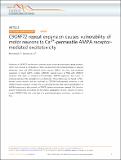C9ORF72 repeat expansion causes vulnerability of motor neurons to Ca2+-permeable AMPA receptor-mediated excitotoxicity
Abstract
Mutations in C9ORF72 are the most common cause of familial amyotrophic lateral sclerosis (ALS). Here, through a combination of RNA-seq and electrophysiological studies on induced pluripotent stem cell (iPSC) derived motor neuron (MNs), we show that increased expression of GluA1 AMPA receptor (AMPAR) subunit occurs in MNs with C9ORF72 mutations that leads to increased Ca2+-permeable AMPAR expression and results in enhanced selective MN vulnerability to excitotoxicity. These deficits are not found in iPSC-derived cortical neurons and are abolished by CRISPR/Cas9-mediated correction of the C9ORF72 repeat expansion in MNs. We also demonstrate that MN-specific dysregulation of AMPAR expression is also present in C9ORF72 patient post mortem material. We therefore present multiple lines of evidence for the specific upregulation of GluA1 subunits in human mutant C9ORF72 MNs that could lead to a potential pathogenic excitotoxic mechanism in ALS.
Citation
Thangaraj Selvaraj , B , Livesey , M , Zhao , C , Gregory , J , James , O , Cleary , E , Chouhan , A K , Gane , A , Perkins , E , Dando , O , Lillico , S , Lee , Y-B , Nishimura , A , Poreci , U , Thankamony , S , Pray , M , Vasistha , N , Magnani , D , Borooah , S , Burr , K , Story , D , McCampbell , A , Shaw , C , Kind , P , Aitman , T J , Whitelaw , B , Wilmut , I , Smith , C , Miles , G B , Hardingham , G , Wyllie , D & Chandran , S 2018 , ' C9ORF72 repeat expansion causes vulnerability of motor neurons to Ca 2+ -permeable AMPA receptor-mediated excitotoxicity ' , Nature Communications , vol. 9 , 347 . https://doi.org/10.1038/s41467-017-02729-0
Publication
Nature Communications
Status
Peer reviewed
ISSN
2041-1723Type
Journal article
Description
Funded by The Wellcome Trust (Grant 092742/Z/10/Z), MNDA (Miles/Oct14/878-792), MRC, Euan MacDonald Centre, UK DRI, DBT-India, ISSF (WT/UoE), Royal Society of Edinburgh (CRF), and Biogen/UoE Joint Discovery Research Collaboration. RNA-Seq raw reads were generated by Edinburgh Genomics, The University of Edinburgh. Edinburgh Genomics is partly supported through core grants from NERC (R8/H10/56), MRC (MR/K001744/1), and BBSRC (BB/J004243/1).Collections
Items in the St Andrews Research Repository are protected by copyright, with all rights reserved, unless otherwise indicated.

